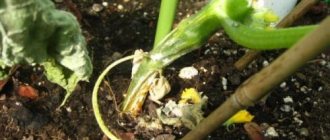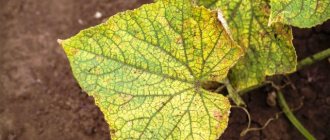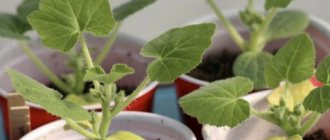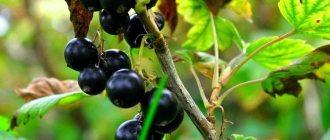Cucumbers are very susceptible to any weather changes, cold snaps, drafts, improper care and unsuitable soil. They can die if something is not taken into account or ignored. But despite this, every garden has beds with cucumbers, because this is one of those vegetables that everyone loves and in different forms.
As soon as something happens to the cucumbers, they show it through the leaves, which turn yellow. That is, if the cucumber leaves suddenly begin to turn yellow, this is a sure sign of a disease that needs to be recognized and cured.
The main cause of yellowing leaves on cucumbers is a disease called chlorosis. This chlorosis may or may not be caused by an infection. To establish this, you need to examine the plant more closely.
Infectious chlorosis. Its causes may be yellow and green mosaic viruses, bacteriosis, and ascochyta.
How to distinguish the signs of a particular pathogen
Ascochyta blight is a disease caused by a fungus during the fruiting period, where it starts with the leaves and eventually affects the entire plant. At the initial stage, the leaves turn slightly yellow, but very quickly darken to black. The fruits are deformed. The fungus does not spread in the soil, but is contained in the seeds of an infected cucumber.
Bacteriosis - in this case, spots of irregular shape appear on the leaves, first in a light shade, and then dark. The cause of bacteriosis may be due to high temperatures and humidity. It may be because the crops are too close to each other. Also, bacteria can carry the remains of infected plants, water, soil or tools that have been in contact with diseased crops.
Yellow and green mosaic is a virus in which leaves gradually turn yellow, from veins to the entire leaf. After which the leaves dry out and die. The pathogen comes from the soil or with insects. With a green mosaic, the leaves curl and wrinkle. Fruits behave the same way.
Non-infectious chlorosis . Here the problem is in the soil, care or climate. For example, there is not enough sun and light, plantings are too close, where both the leaves suffer, covering each other, and the roots, which have no space and do not receive food. Improper watering (too little or too much), heat, micronutrient deficiency. Nitrogen is responsible for greens; if there is not enough of it, the leaves will turn yellow and the shoots will remain weak and thin. Also, magnesium deficiency can be recognized, in which case the leaf will be yellow and the veins will be green. If the leaves turn yellow only at the tops, then you need to add iron.
Treatment methods
For non-infectious chlorosis, action must be taken depending on the cause. If the plantings are too dense and dense, they need to be thinned out. Try replanting if the cucumbers don’t have enough sun and light, as well as if there is not enough space for the roots. Feeding will help improve the situation with micronutrient deficiency. Cucumbers love foliar feeding most of all.
If the cause is still infectious, then in the case of yellow and green mosaics, unfortunately, there is no salvation. It is better to dig up and destroy the crops. If it is bacteriosis or ascochyta blight, then only the affected parts of the plants are destroyed, the remaining plantings are sprayed with a 1% solution of Bordeaux mixture. If the disease is just beginning, this will help the cucumbers quickly produce new shoots. Foliar feeding is carried out for all cucumbers, whether they grow in a greenhouse or in open ground.
Also, do not forget about the existence of preventive measures. If you use them, many diseases can be avoided. These measures relate to choosing the right place for future plantings, purchasing seeds - only trusted brands and sellers. Before planting, the seeds must be disinfected, and during planting it is important to remember a comfortable distance for future plants and their roots.
Main causes of yellowing
Yellowing of leaves in cucumbers is a disease called chlorosis. There are two types of chlorosis: infectious and non-infectious. You can distinguish the type of disease and understand what causes it if you carefully examine the plant. You should pay attention to how the yellowing occurs and whether there are other changes in the leaves.
The causes of chlorosis can be infectious or non-infectious.
Infectious chlorosis
Infectious chlorosis is caused by diseases: yellow mosaic virus, ascochyta, green mosaic, bacteriosis.
Yellow mosaic virus : first the veins all over the leaf turn yellow, then yellow strokes appear, after a while the whole leaf turns yellow. The leaves dry out and fall off.
The causative agent of the disease is found in the soil and is carried by contaminated tools or insects.
Ascochyta blight : light yellow spots first appear on the foliage, which instantly turn brown, and after a while turn black. All other parts of the plant are also affected. Cucumber fruits are deformed. The cause of the disease is seeds collected from a diseased plant.
Green mosaic : chaotic yellow and light green spots form on the leaf. The edges of the sheet bend down, the plate becomes wrinkled. The same thing happens with fruits. They become stained and wrinkled.
Bacteriosis : irregularly shaped spots appear on cucumber leaves. The color is first yellowish, then brown. Pathogens live on plant debris. Activated by sudden temperature changes.
Non-infectious chlorosis
The cause of non-infectious chlorosis is unsuitable soil composition, climatic conditions or improper care.
Causes of non-infectious chlorosis:
- lack of sunlight, which happens if the beds are located near a building or dense trees;
- when cucumber plantings are dense, when the lower leaves are covered by the upper ones;
- when the planting is compacted, when the roots do not have enough space to develop and there is not enough nutrition;
- irregularities in watering. Chlorosis can occur either with insufficient watering or with excessive watering;
- hot weather;
- lack of microelements in the soil.
With a lack of nitrogen, the leaves turn completely yellow and young shoots become thin. The fruits slow down and the tips of the cucumbers become pointed.
With a lack of magnesium, only the veins remain green, the rest turns yellow. The leaf blade becomes thin, as if dried. The fruits ripen quickly and are not eaten.
With a lack of iron, the leaves at the top of the plant turn yellow.
Root rot
If the soil is over-moistened, especially in cold weather, cucumbers may suffer from root rot. It is caused by pathogenic fungi found in the soil. When favorable conditions are created (high humidity, temperature changes, poor air circulation, dense and acidic soil), they begin to multiply quickly and damage plant roots.
What to do
In cold weather, reduce the amount of watering. Do not use cold water for watering cucumbers, the temperature of which is lower than the temperature of the soil.
If you see that the cucumber leaves turn yellow, wither, and the plant dies, cut off the above-ground part, remove the lower leaves and place the cutting in water.
After some time (usually 7-10 days), new roots will form on it, and it can be planted in the ground again. To prevent re-infection, water the soil with a biofungicide solution. For this you can use Fitosporin-M or Trichocin.
Many gardeners are afraid to take cucumber cuttings, believing that this method of propagation is not suitable for this crop. But in vain: roots quickly grow on the cucumber stems, and in this way you can not only save a dying plant, but also increase the amount of planting material.
What to do if cucumber leaves turn yellow
If chlorosis is caused by a non-infectious cause, then the measures for caring for cucumber beds should be reconsidered:
- thickened plantings should be straightened out. Leaves that lacked light will turn green under the rays of the sun. The same will happen if the roots could not develop due to limited space;
- if there is not enough sun due to the wrong place for planting, then the young plants should be replanted by digging them out along with the lump. For better survival, you can lay the lower part of the stem on the ground and pin it. Additional roots form in the place of the sinuses;
- Watering in dry weather should be frequent and abundant. The deeper the soil gets wet, the better. Water only after the soil dries;
- In hot weather, it is advisable to shade cucumber plantings from the midday heat. You can install a light support and stretch white agrofibre with a density of 15 g/m2 over the cucumbers. The height of the canopy must be no less than 1.5 meters above the ground. The space between the agrofiber and cucumbers should be well ventilated.
- If there is a lack of nutrition, it is necessary to add the missing microelements. Cucumbers respond best to foliar feeding. They quickly recover, produce new shoots and set full-fledged fruits;
- If yellowing of the foliage is a sign of yellow or green mosaic, then there is no cure for this disease. If the cucumbers get sick at an early stage of development, then it is best to destroy the plantation and plant new plants in another place. Under favorable conditions, cucumbers grow quickly and form new ovaries throughout the summer.
Reviews
Valentine
I have been growing cucumbers in a greenhouse for sale for several years now. But last year, the leaves of the cucumbers began to turn yellow around the edges. No matter what I did, the problem did not go away. But it turned out to be very simple - they were affected by toxic substances. I had foam plastic in my greenhouse, as soon as I removed it, my cucumbers stopped turning yellow at the tips of the leaves and disappearing. I no longer use polystyrene foam in the greenhouse.
Irina
When growing cucumbers, I prefer folk remedies. Firstly, I change the location of the bed every year. Secondly, I use humus and ash as fertilizer. And thirdly, as a preventive measure, I spray them with a soda solution with yeast. And if pests appear, a solution of soda and iodine helps a lot. With such procedures, my cucumbers are delicious every year.
The main reason why seedlings do not grow and their leaves turn yellow and wither is failure to follow the rules for caring for seedlings, the appearance of diseases or pests. If the seedling planting scheme is followed correctly and preventive measures are taken, unpleasant yellowing and wilting of the leaves can be prevented. It is much easier to follow the rules of care than to spend energy later on restoring the vegetable crop.
How to treat cucumbers so that the leaves do not turn yellow
If the cause of chlorosis is ascochyta blight or bacteriosis, then the following measures should be taken:
- yellowed foliage and damaged parts of the plant are cut off and burned;
- the remaining part is sprayed with a 1% solution of Bordeaux mixture.
This method of control is effective if the disease is not very advanced. New shoots quickly grow from the leaf axils.
If there is a lack of microelements, foliar feeding is carried out. The best time for spraying is in the evening, when the sun drops to the horizon.
- if there is a lack of nitrogen, spray with urea, dissolving 25 g per 5 liters of water;
- if there is not enough magnesium, the leaves are irrigated with a solution of magnesium nitrate, 10 grams per 5 liters of water, or magnesium sulfate, per 5 liters of water - 50 grams of fertilizer;
- If there is a lack of iron, the leaves are sprayed with iron sulfate; for this, 25 grams of fertilizer are added to 5 liters of water.
Foliar feeding is carried out two to three times, with an interval of 10 days.
Basic methods for preventing leaf death
To avoid the appearance of yellow leaves on young cucumbers that have just begun to bear fruit, consider a few tips:
- Water the cucumbers in a timely manner without forcing them to take root to the top ball of soil. If you rarely come to the site, cover the beds with mulch after watering to retain moisture.
- Maintain crop rotation - do not plant cucumbers in the same place every year.
- Feed the plants with organic matter or mineral fertilizers.
- To prevent diseases and prolong fruiting, spray the bushes with an unusual mixture. Soak a loaf of bread in 10 liters of water overnight, knead it in the morning and pour a small bottle of pharmaceutical iodine into the liquid. Dilute a liter of the resulting liquid with a bucket of water, then spray the plants.
- Don't be afraid to use biological agents to control cucumber diseases.
Proper care of cucumbers is the key to a rich harvest. Growing them will become easier every year, because you will understand why the leaves may turn yellow.
If you encounter a situation where all known causes do not match the symptoms, contact a professional. One consultation can save the harvest.
Why do the leaves of cucumbers turn yellow in a greenhouse?
Cucumbers growing in a greenhouse may also suddenly begin to turn yellow.
One of the reasons is insufficiently nutritious soil. Crop rotation is not always observed in the greenhouse, and cucumbers are grown on the same land for several years in a row. This leads to soil depletion and a lack of microelements that cucumbers need for full development.
Another reason is the special microclimate in the greenhouse. On a sunny day, the air temperature rises and the soil warms up greatly. If you water cucumbers with cool water, they will experience stress, which will cause some of the roots to die. The roots do not absorb the required amount of moisture and nutrition from the ground. The leaves begin to turn yellow and dry out, and the ovaries crumble.
Leaves may turn yellow due to overheating on a hot sunny day.
What to do if the leaves of cucumbers in the greenhouse turn yellow:
- carry out foliar fertilizing with mineral fertilizers;
- Irrigate with water previously heated in the sun;
- on hot days, shade the greenhouse by covering its roof with white material.
How pests destroy cucumber leaves
If insects get to the cucumbers, the leaves of the plants may turn yellow, because vital parts of the bush are attacked. You may encounter the following pests:
- ants;
- melon aphids;
- slugs;
- spider mite;
- whiteflies.
Fighting spider mites and whiteflies
Spider mites are one of the most dangerous pests that feed on cucumber greens and live under the leaves. There are especially many ticks in the hot months, when they are capable of destroying an entire garden bed. To combat the pest, you need to disinfect the area by treating the ground with an infusion of onion peels (about 200 grams of dry peels per 10 liters of water). Monitor watering - ticks love dry areas.
Spider mites are a dangerous pest
The whitefly is a very prolific insect that places its larvae on cucumbers.
They suck sap from plants, so their leaves may turn yellow. It is difficult to fight whiteflies, so it is better to immediately resort to spraying the garden beds with special preparations. Growing tobacco near cucumbers will also help, because insects cannot stand its smell.
What does a whitefly look like?
How to get rid of slugs, ants and aphids
You can get rid of slugs and ants by regularly loosening the soil and using baits. For ants, they are made from bottles of sweet water, and for slugs, from pieces of cardboard or planks, under which the insects will hide at night. Early in the morning, traps should be removed along with the pests caught in them and taken away.
Slugs feed on cucumber leaves and damage plants
Another dangerous pest is aphids. If you notice a colony of it in your garden, try to immediately destroy all the weeds that surround the cucumber bed, because these insects can live on them too.
Also spray all plants with a solution based on wood ash. To prepare it, mix 400 g of ash and 100 g of grated laundry soap in 20 liters of water (this is necessary for better adhesion of the solution to the leaves).
What to do if cucumber leaves turn yellow at the edges
If a yellow border appears along the edge of the leaf, but the middle does not change color, this indicates that the cucumbers do not have enough potassium. After some time, the edge curls down and dries out.
The lack of potassium can be compensated for by feeding the cucumbers leaves with potassium sulfate. 30 grams of powder are diluted in 5 liters of water, treatment is carried out after sunset. Fertilizers can be applied at the root, but you just need to water them first.
How to deal with yellowing leaves
Beginning gardeners do not know what to do if the cucumber seedlings turn yellow. When the leaves begin to turn yellow, you need to use products that will help get rid of the problem.
These include:
- Kefir solution. To prepare this product, 7-8 liters of water are mixed with two liters of kefir. Then 100-150 grams of sugar are added to the mixture. The prepared solution is used for watering and spraying bushes.
- Soap mixture. This is an effective folk solution for eliminating yellowness. To make a spray, add 20 drops of iodine and 25 grams of grated soap to a liter of water.
- Urea. When creating the mixture, 40 grams of urea are added to a ten-liter container of water. One and a half liters of liquid are consumed for each bush.
Prevention
Preventive measures can avoid many problems associated with yellowing of foliage. Prevention includes:
- deliberate choice of location for cucumber plantings (crop rotation, illumination of the area, soil composition should be taken into account);
- purchasing seeds only from trusted suppliers, disinfecting them before planting;
- maintaining the distance between plants;
- watering with warm water;
- timely application of fertilizers.
By following simple agricultural practices, yellowing of cucumbers can be avoided.
You may also find the following materials useful:
- Peas: planting, care, cultivation
- Peas in open ground: planting dates, care and harvesting
- Why hill potatoes and how to do it correctly
- Reasons why you should not apply manure to the hole before planting garlic
- How to care for tomatoes in a greenhouse after planting?











